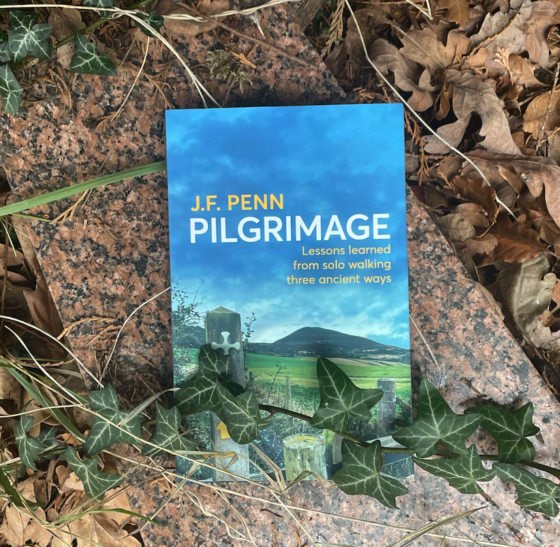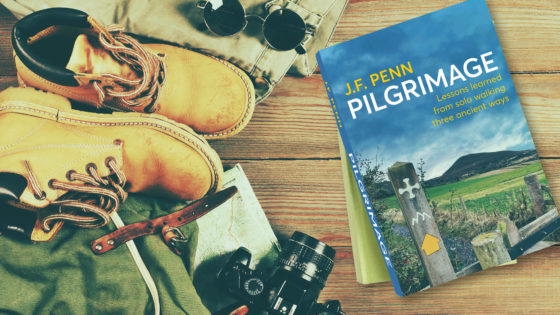Player FMアプリでオフラインにしPlayer FMう!
The Call To Pilgrimage, Resilience, And Embracing Challenge With J.F. Penn
Manage episode 353679886 series 2496001
Why is resilience such an important part of pilgrimage? How can embracing the challenge of the way help in daily life? Why do we need to heed the call to pilgrimage before it’s too late?
I’m Jo Frances Penn and in this episode, I share some clips from podcast interviews I’ve done around my new book, Pilgrimage: Lessons Learned from Solo Walking Three Ancient Ways. Thanks to Travel Writing World with Jeremy Bassetti, Into the Woods with Holly Worton, and Sacred Steps with Kevin Donahue, podcasts you will enjoy as listeners to this show.
As this goes out, Pilgrimage is available now in a special limited edition signed hardback, as well as a paperback, ebook, audiobook narrated by me, large print edition, and a workbook.
In this episode, I talk about:
- Which were the three ancient ways I walked and why they’re interesting even if you’re not religious
- What I learned along the way
- The three types of energy you need at the different stages
- How pilgrimage reminds us we are animals, and how it gives a much-needed perspective on life.
In this first clip from the Travel Writing World podcast with Jeremy Bassetti, I talk about the specific pilgrimages I walked and why they’re interesting, even if you’re not religious.
Jeremy Bassetti: The book is called Pilgrimage: Lessons Learned from Solo Walking Three Ancient Ways.
What were the three pilgrimage routes that you took during your walking adventures?
Jo Frances Penn: So, I did the Pilgrims’ Way first, which is from Southwark Cathedral in London to Canterbury Cathedral in the southeast of England. And that’s the route of The Canterbury Tales, which I’m sure people have heard of, medieval tales by Geoffrey Chaucer and it was about visiting the shrine of Thomas Becket who was martyred under Henry II.
And it was the pandemic and it was also the 850-year anniversary of the Becket martyrdom. So that kind of helped me decide to do that one. I couldn’t go and do the Camino during the pandemic because of course we couldn’t travel. And also, I’d highly recommend it as an easy route for a first multi-day solo.
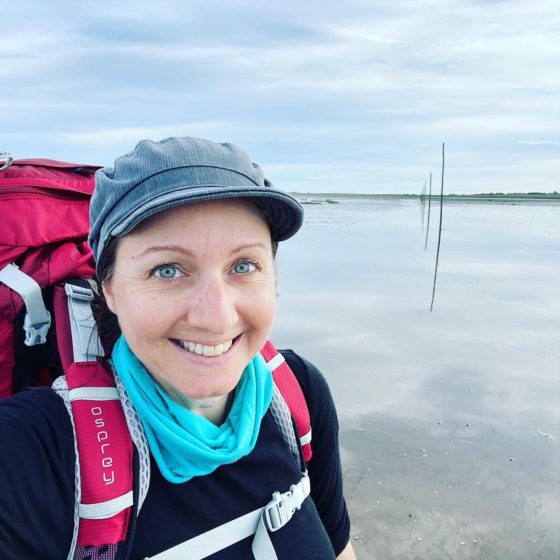
Then the second one was the St Cuthbert’s Way from Melrose in Scotland to Lindisfarne, Holy Island on the northeast coast of England. And St. Cuthbert was a medieval monk and a bishop. And, I wrote about Lindisfarne in my thriller Day of the Vikings, so I really wanted to do that and that was a spectacular route. I highly recommend the Cuthbert’s.
Then finally there was the Camino, a goal I’ve had for several decades, and I did the Camino de Santiago Portuguese Coastal route from Porto in Portugal, up to Santiago De Compostela. I feel like the Camino is quite mythical for many people and certainly for me.
And when I had COVID the year before, in 2021, and I was really sick and I realized that maybe one day I would not be able to walk — obviously at some point none of us will be able to walk, right, we will be dead! — and I thought, well, if I don’t do this now, maybe I’ll never do it. And I have said I wanted to do it for many years and now I’ve got to do it.
So I committed and I’m so glad I did that route finally, and it really enabled me to finish the book, but yes, those were the three.
Jeremy Bassetti: So I mean, these three pilgrimage routes that you mentioned here, that you went on, all have religious connotations, but you mentioned in the book that you are more secular-minded.
How have you come to understand the act of pilgrimage from this secular position or perspective?
Jo Frances Penn: Well, I am not a Christian, although I have a chapter in the book about my faith history. Many of us have this faith history by midlife, you know, an experience of finding God and losing him again or whatever that means to the individual.
But I’m certainly spiritual. I consider myself spiritual and I mean, you talk about genius loci, the spirit of the place. And I absolutely have had moments of connection with whatever we want to call it, the universe or God if you want, in different places. And certainly did on these routes too.
So while I am secular — as in I don’t adhere to a particular religion — I absolutely respect people of faith. I have a master’s degree in Theology, and pretty much all my fiction is based on religion and I love religious places.
What is wonderful about these pilgrimage routes, these ancient ways, is that people have walked these particular routes in Europe for a thousand years, and that’s what gives them a lot of resonance.
It also means they’re packed full of amazing churches and cathedrals and beautiful architecture. And I love architecture. I’m a super fan of architecture. So I guess the pilgrimage aspect is both the walking from here to here, the historical side of it, and the beautiful places along the way.
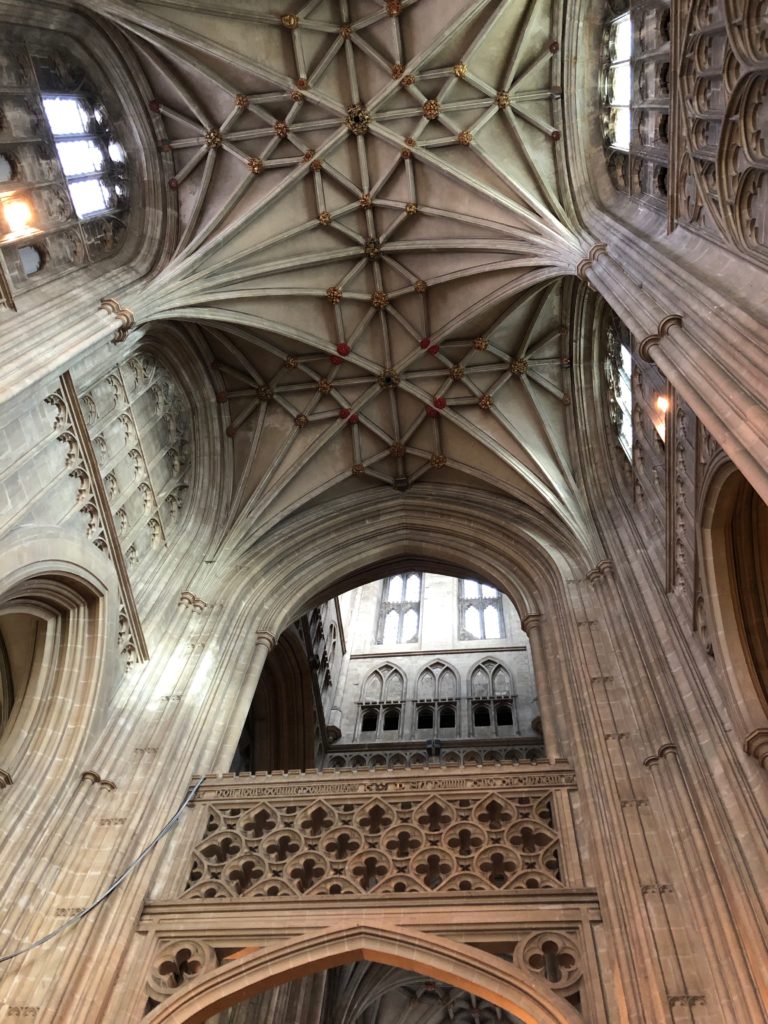
My discussion with Jeremy continues into why walking is healing and why pilgrimage in particular can heal deeper wounds of the soul, how the gifts of pilgrimage come with hindsight, why we travel, and how to figure out what kind of travel book to write.
You can listen to the rest of the episode on Travel Writing World on your favorite podcast app. Jeremy also has interviews with travel writers like Pico Iyer, Colin Thubron, and many more on his show, or check out his website TravelWritingWorld.com
In this next section, I’m interviewed by Holly Worton on her Into The Woods Podcast, which is fantastic for solo adventures, pushing your comfort zone in the outdoors and in life, and generally has lots of interviews with people about all kinds of travel.
In this clip, we talk about what I learned from pilgrimage including the aspect of memento mori, and then the three types of energy involved in a pilgrimage.
***
Holly Worton:
What did you learn from your pilgrimages? What did you get out of them?
Because I know you’d said that you walked them during very challenging times, which of course the entire world was going through
Jo Frances Penn: Yes, well, I think the biggest thing was resilience. And again, I mean, you talk about this with the solo adventures and or anything that pushes your comfort zone.
So, for example, I’ve done a lot of walking holidays with tour companies like Exodus, and I’m reasonably fit. So the walking aspect is one thing, but doing it alone is difficult. And in fact, you recommended the NNAS navigation course.
Holly: Yes, of course.
Jo: I went on one of those. Because I was like, ‘I don’t know how to read a map.’ Well, I did in Girl Guides, but you know, it’s been a long time. So I re-skilled.
And then it was facing up to the fears around being alone or getting lost, which I did — and getting sick. I didn’t get sick on the walks but of course, the fear of sickness while walking during the beginning of the pandemic, particularly when none of us had got it yet. We were very afraid, even though now we know there was hardly any round at that time, but it kind of emerged.
Walking in pain was a challenge. So on the Camino, I had pretty bad blisters the second week and you have to get up every morning and you’re like, ‘I really don’t want to walk on these feet,’ but I’m going to do it anyway.
So yes, I think this gift of structure, the boundaries, the resilience of learning new things. Just the escape from daily life is also really important and that perspective that we talked about. And then the other thing that I always think about a lot is the memento mori idea of, “remember, you will die,” but in a positive way, as in life is short, so make the most of it.
I think it’s much more obvious on pilgrimage routes because for example, if you go to Southwark Cathedral in London, at the start of the Pilgrim’s Way, that has been a church for a thousand years, and then you get to Canterbury and again, it’s been there since medieval times. You walk through these places and you realize how many other people have been here or the people who built those sculptures.
And what’s interesting at Southwark and Canterbury, and you rarely see such things, but there are these two cadaver tombs. That’s what they’re called. The tombs have a cadaver on. Normally if you see a medieval tomb or any kind of tomb, there’s maybe a knight lying on the top in full armor or a noble person with all their robes, and they look like a living human lying down on a bed or something.
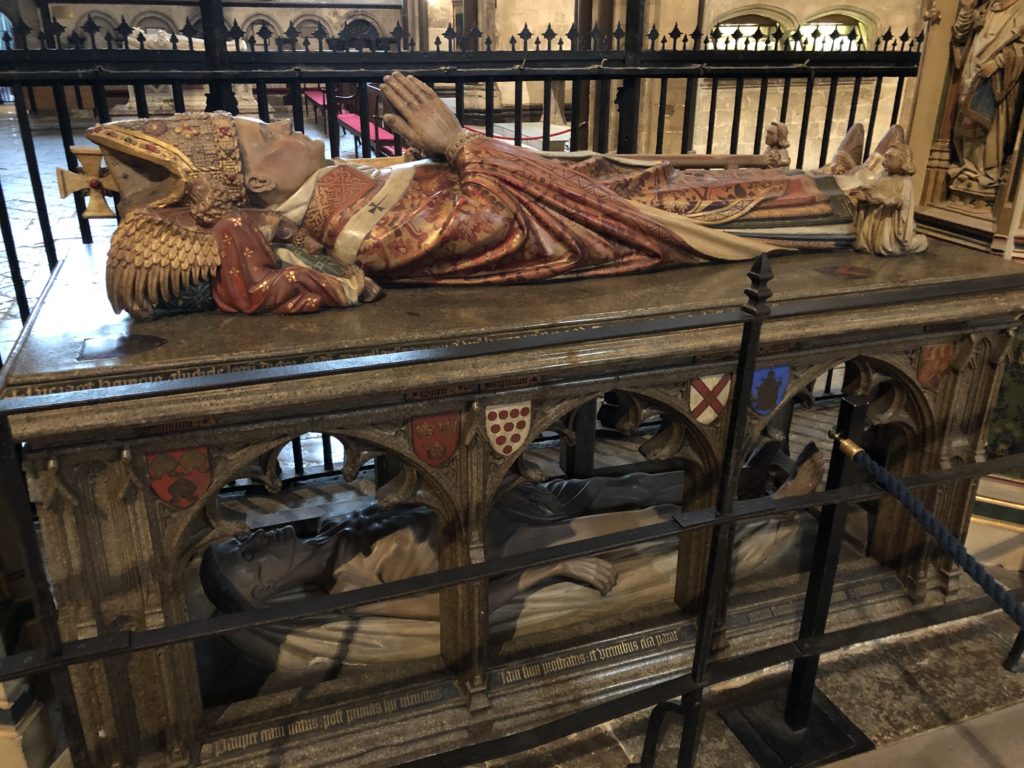
But both Southwark and Canterbury have these cadaver tombs where the figure on the top is a dead body. And this is very rare. In Canterbury it’s even more unusual because it’s like bunk beds. The Archbishop built this while he was alive, so he could look at it every time he preached.
On the bottom level is him as a cadaver naked except for a little shroud. Then on the bunk bed above is him dressed in his full archbishop’s finery. Obviously, it’s meant to teach you that it doesn’t matter what you are in life. One day you will just be this dead body and you will turn to dust.
And I find this invigorating and it helps me live every day better because I know I’m going to die. And it was weird on the Camino because it was the second or third day of my Camino when Queen Elizabeth II died.
And so I walked the route, and that whole week the TVs were full of her life. So often we look at ourselves in the mirror and we might see a picture of us as younger people and be like, oh, you know, I’m getting old, or whatever. But there are pictures of the Queen her entire life, and they were all on TV, so you could actually see this woman’s life from child to middle age to death.
And it was that memento mori idea again that we remember as we walk and to make the most of these things while we’re alive. Because one day I will not be able to walk the Camino or another pilgrimage. So do the things you want to do while you still can — but in a positive way!
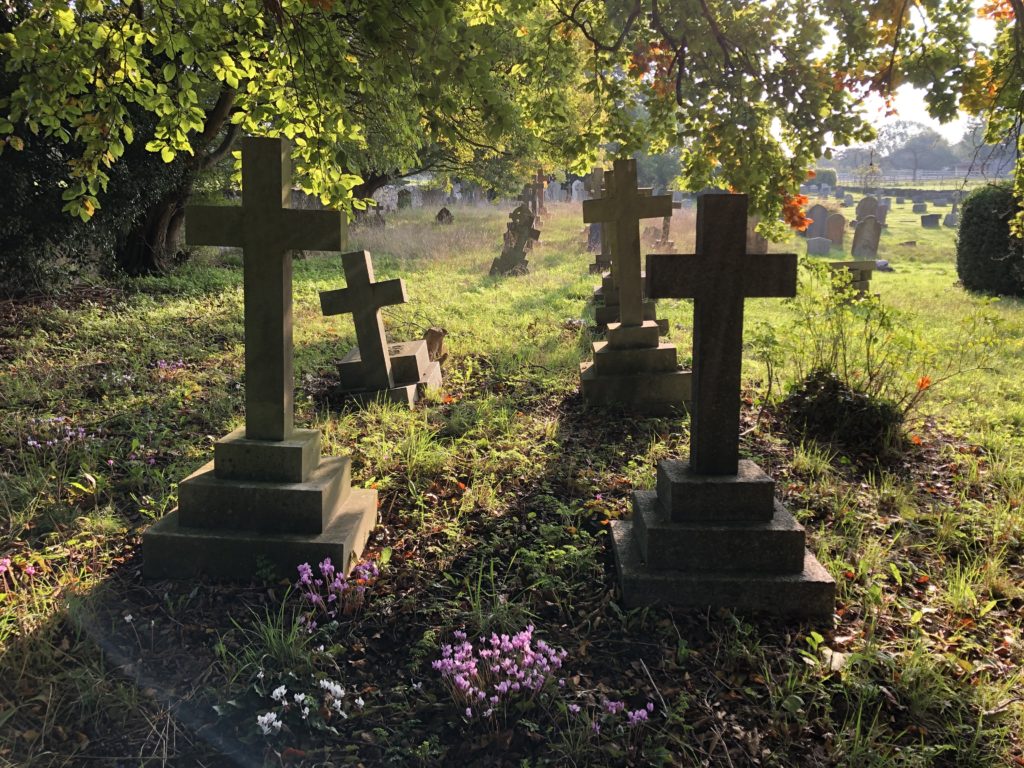
Holly Worton:
So in your book, you talk about the three stages of a pilgrimage, and I really like this perspective. So what are they?
Jo Frances Penn: The first one is starting energy, which is turning it from a dream into a goal.
So it took me like 20 years to actually book the Camino, 25 years or whatever. So it’s the organization, it’s booking time off, it’s training, it’s getting past those fears and obstacles. It’s figuring out all the practical stuff because you think, oh yes, I’ll just be walking and I’ll have my spiritual moments, but there’s a hell of a lot of practical stuff to actually get it going.
So starting energy is everything up to the night before and then pushing through energy is once you are actually on the route. It’s ‘I really want to give up because I’m in pain’ or I’m actually injured, or I’m really, really bored with wearing the same clothes and washing them every day and the same food, the same bread, you know, whatever.
Holly: It’s the other challenges along the way, like the Camino you mentioned being busy —
Jo: Yes, those last few days are busy and I was annoyed at other pilgrims, I was like, I am so annoyed that this pilgrim is playing music. Or I’m annoyed that there are literally a hundred pilgrims ahead of me. I can see them all on the path, and I do not like this.
And that was a challenge in itself because whereas the Cuthbert’s, for example, I was alone on a hill in a storm. And that’s a completely different challenge. But that pushing through energy is, “I am going to finish. I can do this, I will get through this. I just need to put one foot in front of the other and keep going.”
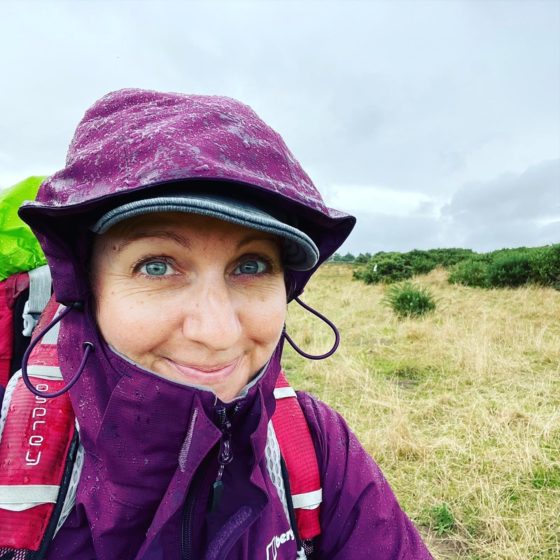
So that’s the pushing through energy that gets you to the end. And then the finishing energy is that return, and the reflection and learning the lessons. Maybe it’s printing the pictures that you did or taking your journal and turning it into something else, facing the questions that you thought of while you were on the walk.
Because when you get home, what happens is you put your clothes in the wash. That’s like one of the first things that you do. You get all the crap out of your backpack and you give your partner a cuddle and you cuddle your pets and then you log onto your email and you start all the backlog of stuff you need to catch up on and paying bills, and it’s very easy to just get back and get on with life.
But you need that finishing energy to review what happened because the gifts of pilgrimage take some time.
It’s so weird because I thought I would write three guidebooks like you have your guidebooks, your reflective books, and yet this book, it just wouldn’t come. I couldn’t figure it out.
And then when I finished my Camino, I finally understood what the pattern was and what I learned from all three routes. So the subtitle is Lessons Learned from Solo Walking Three Ancient Ways. And I almost feel like I couldn’t have learned those lessons without all three of them.
And I say in the book, if you don’t feel that there are any gifts from your pilgrimage, then perhaps you haven’t walked enough. Maybe you need to go on another pilgrimage. I thought I could change my life with a weekend walk but no, it took longer than I expected.
***
You can listen to the rest of the episode on the Into The Woods Podcast on your favorite podcast app — and Holly and I talk about why pilgrimage is different to other long-distance walks, some of the interesting historical and spiritual aspects, how we both remember reading Paulo Coelho’s Pilgrimage book back in the 90s, how we both enjoy the feeling of insignificance, why we have to revisit the memories of our trips or they fade away, and much more.
Holly’s show is one I personally listen to and I think you’ll enjoy the range of her interviews. She also has guidebooks to solo walking routes like The Ridgeway and more, and she has been on this podcast before in episode 42 about solo walking — In fact, my discussions with Holly about her adventures and her books helped inspire my own, so definitely check out her show.
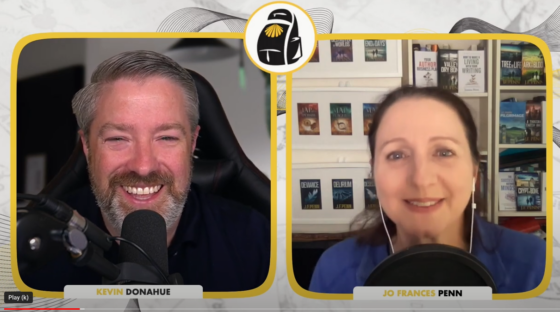
In this final clip, I talk to Kevin Donahue on the Sacred Steps Podcast which is all about pilgrimage, and Kevin has had some fantastic guests on to talk about lots of different routes, and he’s also been on this show in episode 86 talking about his pilgrimages. We almost met in person as we crossed the sands to Lindisfarne just days apart, but we never quite made it, so it was lovely to talk again. You can listen as a podcast or watch the interview on YouTube.
In this segment, we talk about how pilgrimage reminds us we are animals, and how it gives a much-needed perspective on life.
***
Kevin:
How has this series of walks and these journeys influenced or impacted your sense of spirituality?
Jo Frances Penn: There’s a book in the Bible that I really like, Ecclesiastes. It’s one of my favorite books in the Bible. And I have a Master’s in Theology even though I’m not a Christian anymore. But there’s a quote that I actually put into the book, “As for humans, God tests them so they might know they are animals.”
And I just love that quote because that to me is something I need to remember. My animal body is what walks a pilgrimage. And my spiritual mind and my intellectual mind are part of my physical body.
And I feel like so much sometimes, like you and I, we are not physically in the same space. We can see each other, but we’re connecting with our minds across this virtual space. And yet, pilgrimage is such a physical journey.
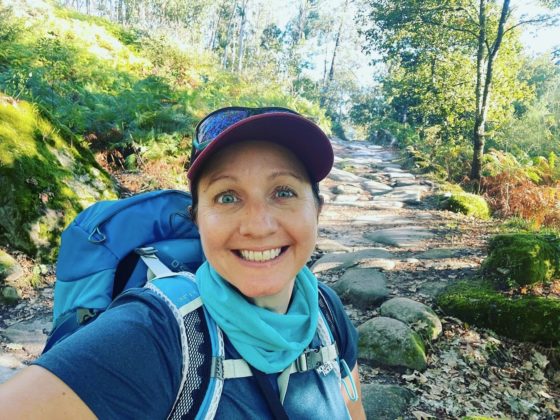
And also I was going through the female experience of midlife, hormonal changes, which have a very animal effect. You are just completely out of control. You are like, what the hell is happening to me? And I have no control over this.
And then like we mentioned, the tides and all these transient things and the idea of memento mori. So when I walked the Camino Portuguese, Queen Elizabeth II died in the UK and as I walked every day that week, her pictures were on all the TVs that you walked past in the cafes and stuff.
So they showed her whole life, the beautiful young woman who ascended the throne across the challenges of midlife to her old age, her husband dying, and her dying. And it was like, I’m not a queen, but I’m another woman. And I see this woman’s life and it will all end, and to me that is so important to remember for my spiritual side.
It’s a sense of being part of this wonderful world and this amazing universe, whether you believe God created it or not. The sense of being an animal walking across the face of the world and nothing else matters. Like that’s the thing. Nothing else matters.
Now, of course, everything matters. Your family matters. My husband matters. My cats matter, my work matters.
But when you are walking a pilgrimage and you have that simple life — and the gratitude. I am so grateful for this cold beer or this shade of this tree or the hot shower when I’m really sweaty and it’s gross and I just want a shower or the painkillers. I’m so grateful for the pharmaceutical industry, for my blister plasters and my painkillers, and my Albarino wine and like all those things.
It’s that perspective. That’s what it comes down to. Being able to hold onto that perspective when everything feels overwhelming and you’re just like, what is the point?
And then you realize this is the point. The point is being an animal in the world.
***
I hope you found those clips interesting, and you can listen to the complete episodes on the podcast feeds for Travel Writing World with Jeremy Bassetti, Into the Woods with Holly Worton, and Sacred Steps with Kevin Donahue.
Pilgrimage is available now in a special limited edition signed hardback, as well as a paperback, ebook, audiobook narrated by me, large print edition, and a workbook.
Happy travels until next time.
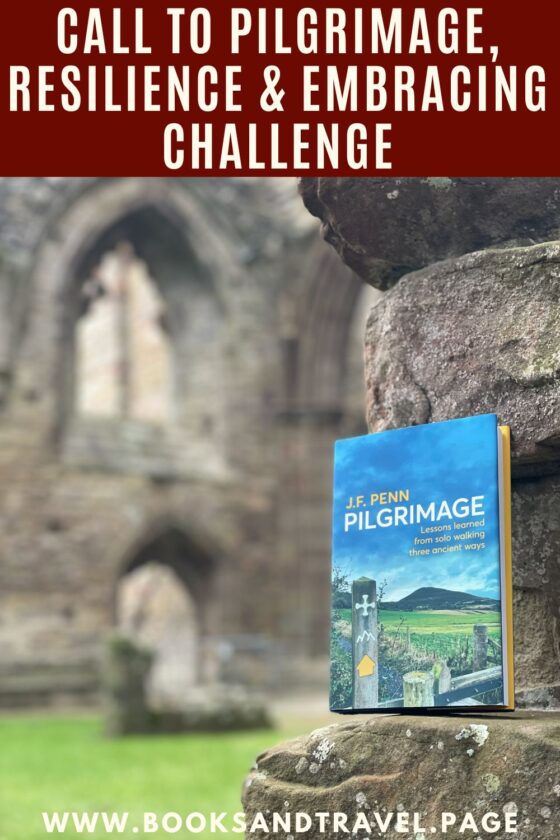
The post The Call To Pilgrimage, Resilience, And Embracing Challenge With J.F. Penn appeared first on Books And Travel.
92 つのエピソード
Manage episode 353679886 series 2496001
Why is resilience such an important part of pilgrimage? How can embracing the challenge of the way help in daily life? Why do we need to heed the call to pilgrimage before it’s too late?
I’m Jo Frances Penn and in this episode, I share some clips from podcast interviews I’ve done around my new book, Pilgrimage: Lessons Learned from Solo Walking Three Ancient Ways. Thanks to Travel Writing World with Jeremy Bassetti, Into the Woods with Holly Worton, and Sacred Steps with Kevin Donahue, podcasts you will enjoy as listeners to this show.
As this goes out, Pilgrimage is available now in a special limited edition signed hardback, as well as a paperback, ebook, audiobook narrated by me, large print edition, and a workbook.
In this episode, I talk about:
- Which were the three ancient ways I walked and why they’re interesting even if you’re not religious
- What I learned along the way
- The three types of energy you need at the different stages
- How pilgrimage reminds us we are animals, and how it gives a much-needed perspective on life.
In this first clip from the Travel Writing World podcast with Jeremy Bassetti, I talk about the specific pilgrimages I walked and why they’re interesting, even if you’re not religious.
Jeremy Bassetti: The book is called Pilgrimage: Lessons Learned from Solo Walking Three Ancient Ways.
What were the three pilgrimage routes that you took during your walking adventures?
Jo Frances Penn: So, I did the Pilgrims’ Way first, which is from Southwark Cathedral in London to Canterbury Cathedral in the southeast of England. And that’s the route of The Canterbury Tales, which I’m sure people have heard of, medieval tales by Geoffrey Chaucer and it was about visiting the shrine of Thomas Becket who was martyred under Henry II.
And it was the pandemic and it was also the 850-year anniversary of the Becket martyrdom. So that kind of helped me decide to do that one. I couldn’t go and do the Camino during the pandemic because of course we couldn’t travel. And also, I’d highly recommend it as an easy route for a first multi-day solo.

Then the second one was the St Cuthbert’s Way from Melrose in Scotland to Lindisfarne, Holy Island on the northeast coast of England. And St. Cuthbert was a medieval monk and a bishop. And, I wrote about Lindisfarne in my thriller Day of the Vikings, so I really wanted to do that and that was a spectacular route. I highly recommend the Cuthbert’s.
Then finally there was the Camino, a goal I’ve had for several decades, and I did the Camino de Santiago Portuguese Coastal route from Porto in Portugal, up to Santiago De Compostela. I feel like the Camino is quite mythical for many people and certainly for me.
And when I had COVID the year before, in 2021, and I was really sick and I realized that maybe one day I would not be able to walk — obviously at some point none of us will be able to walk, right, we will be dead! — and I thought, well, if I don’t do this now, maybe I’ll never do it. And I have said I wanted to do it for many years and now I’ve got to do it.
So I committed and I’m so glad I did that route finally, and it really enabled me to finish the book, but yes, those were the three.
Jeremy Bassetti: So I mean, these three pilgrimage routes that you mentioned here, that you went on, all have religious connotations, but you mentioned in the book that you are more secular-minded.
How have you come to understand the act of pilgrimage from this secular position or perspective?
Jo Frances Penn: Well, I am not a Christian, although I have a chapter in the book about my faith history. Many of us have this faith history by midlife, you know, an experience of finding God and losing him again or whatever that means to the individual.
But I’m certainly spiritual. I consider myself spiritual and I mean, you talk about genius loci, the spirit of the place. And I absolutely have had moments of connection with whatever we want to call it, the universe or God if you want, in different places. And certainly did on these routes too.
So while I am secular — as in I don’t adhere to a particular religion — I absolutely respect people of faith. I have a master’s degree in Theology, and pretty much all my fiction is based on religion and I love religious places.
What is wonderful about these pilgrimage routes, these ancient ways, is that people have walked these particular routes in Europe for a thousand years, and that’s what gives them a lot of resonance.
It also means they’re packed full of amazing churches and cathedrals and beautiful architecture. And I love architecture. I’m a super fan of architecture. So I guess the pilgrimage aspect is both the walking from here to here, the historical side of it, and the beautiful places along the way.

My discussion with Jeremy continues into why walking is healing and why pilgrimage in particular can heal deeper wounds of the soul, how the gifts of pilgrimage come with hindsight, why we travel, and how to figure out what kind of travel book to write.
You can listen to the rest of the episode on Travel Writing World on your favorite podcast app. Jeremy also has interviews with travel writers like Pico Iyer, Colin Thubron, and many more on his show, or check out his website TravelWritingWorld.com
In this next section, I’m interviewed by Holly Worton on her Into The Woods Podcast, which is fantastic for solo adventures, pushing your comfort zone in the outdoors and in life, and generally has lots of interviews with people about all kinds of travel.
In this clip, we talk about what I learned from pilgrimage including the aspect of memento mori, and then the three types of energy involved in a pilgrimage.
***
Holly Worton:
What did you learn from your pilgrimages? What did you get out of them?
Because I know you’d said that you walked them during very challenging times, which of course the entire world was going through
Jo Frances Penn: Yes, well, I think the biggest thing was resilience. And again, I mean, you talk about this with the solo adventures and or anything that pushes your comfort zone.
So, for example, I’ve done a lot of walking holidays with tour companies like Exodus, and I’m reasonably fit. So the walking aspect is one thing, but doing it alone is difficult. And in fact, you recommended the NNAS navigation course.
Holly: Yes, of course.
Jo: I went on one of those. Because I was like, ‘I don’t know how to read a map.’ Well, I did in Girl Guides, but you know, it’s been a long time. So I re-skilled.
And then it was facing up to the fears around being alone or getting lost, which I did — and getting sick. I didn’t get sick on the walks but of course, the fear of sickness while walking during the beginning of the pandemic, particularly when none of us had got it yet. We were very afraid, even though now we know there was hardly any round at that time, but it kind of emerged.
Walking in pain was a challenge. So on the Camino, I had pretty bad blisters the second week and you have to get up every morning and you’re like, ‘I really don’t want to walk on these feet,’ but I’m going to do it anyway.
So yes, I think this gift of structure, the boundaries, the resilience of learning new things. Just the escape from daily life is also really important and that perspective that we talked about. And then the other thing that I always think about a lot is the memento mori idea of, “remember, you will die,” but in a positive way, as in life is short, so make the most of it.
I think it’s much more obvious on pilgrimage routes because for example, if you go to Southwark Cathedral in London, at the start of the Pilgrim’s Way, that has been a church for a thousand years, and then you get to Canterbury and again, it’s been there since medieval times. You walk through these places and you realize how many other people have been here or the people who built those sculptures.
And what’s interesting at Southwark and Canterbury, and you rarely see such things, but there are these two cadaver tombs. That’s what they’re called. The tombs have a cadaver on. Normally if you see a medieval tomb or any kind of tomb, there’s maybe a knight lying on the top in full armor or a noble person with all their robes, and they look like a living human lying down on a bed or something.

But both Southwark and Canterbury have these cadaver tombs where the figure on the top is a dead body. And this is very rare. In Canterbury it’s even more unusual because it’s like bunk beds. The Archbishop built this while he was alive, so he could look at it every time he preached.
On the bottom level is him as a cadaver naked except for a little shroud. Then on the bunk bed above is him dressed in his full archbishop’s finery. Obviously, it’s meant to teach you that it doesn’t matter what you are in life. One day you will just be this dead body and you will turn to dust.
And I find this invigorating and it helps me live every day better because I know I’m going to die. And it was weird on the Camino because it was the second or third day of my Camino when Queen Elizabeth II died.
And so I walked the route, and that whole week the TVs were full of her life. So often we look at ourselves in the mirror and we might see a picture of us as younger people and be like, oh, you know, I’m getting old, or whatever. But there are pictures of the Queen her entire life, and they were all on TV, so you could actually see this woman’s life from child to middle age to death.
And it was that memento mori idea again that we remember as we walk and to make the most of these things while we’re alive. Because one day I will not be able to walk the Camino or another pilgrimage. So do the things you want to do while you still can — but in a positive way!

Holly Worton:
So in your book, you talk about the three stages of a pilgrimage, and I really like this perspective. So what are they?
Jo Frances Penn: The first one is starting energy, which is turning it from a dream into a goal.
So it took me like 20 years to actually book the Camino, 25 years or whatever. So it’s the organization, it’s booking time off, it’s training, it’s getting past those fears and obstacles. It’s figuring out all the practical stuff because you think, oh yes, I’ll just be walking and I’ll have my spiritual moments, but there’s a hell of a lot of practical stuff to actually get it going.
So starting energy is everything up to the night before and then pushing through energy is once you are actually on the route. It’s ‘I really want to give up because I’m in pain’ or I’m actually injured, or I’m really, really bored with wearing the same clothes and washing them every day and the same food, the same bread, you know, whatever.
Holly: It’s the other challenges along the way, like the Camino you mentioned being busy —
Jo: Yes, those last few days are busy and I was annoyed at other pilgrims, I was like, I am so annoyed that this pilgrim is playing music. Or I’m annoyed that there are literally a hundred pilgrims ahead of me. I can see them all on the path, and I do not like this.
And that was a challenge in itself because whereas the Cuthbert’s, for example, I was alone on a hill in a storm. And that’s a completely different challenge. But that pushing through energy is, “I am going to finish. I can do this, I will get through this. I just need to put one foot in front of the other and keep going.”

So that’s the pushing through energy that gets you to the end. And then the finishing energy is that return, and the reflection and learning the lessons. Maybe it’s printing the pictures that you did or taking your journal and turning it into something else, facing the questions that you thought of while you were on the walk.
Because when you get home, what happens is you put your clothes in the wash. That’s like one of the first things that you do. You get all the crap out of your backpack and you give your partner a cuddle and you cuddle your pets and then you log onto your email and you start all the backlog of stuff you need to catch up on and paying bills, and it’s very easy to just get back and get on with life.
But you need that finishing energy to review what happened because the gifts of pilgrimage take some time.
It’s so weird because I thought I would write three guidebooks like you have your guidebooks, your reflective books, and yet this book, it just wouldn’t come. I couldn’t figure it out.
And then when I finished my Camino, I finally understood what the pattern was and what I learned from all three routes. So the subtitle is Lessons Learned from Solo Walking Three Ancient Ways. And I almost feel like I couldn’t have learned those lessons without all three of them.
And I say in the book, if you don’t feel that there are any gifts from your pilgrimage, then perhaps you haven’t walked enough. Maybe you need to go on another pilgrimage. I thought I could change my life with a weekend walk but no, it took longer than I expected.
***
You can listen to the rest of the episode on the Into The Woods Podcast on your favorite podcast app — and Holly and I talk about why pilgrimage is different to other long-distance walks, some of the interesting historical and spiritual aspects, how we both remember reading Paulo Coelho’s Pilgrimage book back in the 90s, how we both enjoy the feeling of insignificance, why we have to revisit the memories of our trips or they fade away, and much more.
Holly’s show is one I personally listen to and I think you’ll enjoy the range of her interviews. She also has guidebooks to solo walking routes like The Ridgeway and more, and she has been on this podcast before in episode 42 about solo walking — In fact, my discussions with Holly about her adventures and her books helped inspire my own, so definitely check out her show.

In this final clip, I talk to Kevin Donahue on the Sacred Steps Podcast which is all about pilgrimage, and Kevin has had some fantastic guests on to talk about lots of different routes, and he’s also been on this show in episode 86 talking about his pilgrimages. We almost met in person as we crossed the sands to Lindisfarne just days apart, but we never quite made it, so it was lovely to talk again. You can listen as a podcast or watch the interview on YouTube.
In this segment, we talk about how pilgrimage reminds us we are animals, and how it gives a much-needed perspective on life.
***
Kevin:
How has this series of walks and these journeys influenced or impacted your sense of spirituality?
Jo Frances Penn: There’s a book in the Bible that I really like, Ecclesiastes. It’s one of my favorite books in the Bible. And I have a Master’s in Theology even though I’m not a Christian anymore. But there’s a quote that I actually put into the book, “As for humans, God tests them so they might know they are animals.”
And I just love that quote because that to me is something I need to remember. My animal body is what walks a pilgrimage. And my spiritual mind and my intellectual mind are part of my physical body.
And I feel like so much sometimes, like you and I, we are not physically in the same space. We can see each other, but we’re connecting with our minds across this virtual space. And yet, pilgrimage is such a physical journey.

And also I was going through the female experience of midlife, hormonal changes, which have a very animal effect. You are just completely out of control. You are like, what the hell is happening to me? And I have no control over this.
And then like we mentioned, the tides and all these transient things and the idea of memento mori. So when I walked the Camino Portuguese, Queen Elizabeth II died in the UK and as I walked every day that week, her pictures were on all the TVs that you walked past in the cafes and stuff.
So they showed her whole life, the beautiful young woman who ascended the throne across the challenges of midlife to her old age, her husband dying, and her dying. And it was like, I’m not a queen, but I’m another woman. And I see this woman’s life and it will all end, and to me that is so important to remember for my spiritual side.
It’s a sense of being part of this wonderful world and this amazing universe, whether you believe God created it or not. The sense of being an animal walking across the face of the world and nothing else matters. Like that’s the thing. Nothing else matters.
Now, of course, everything matters. Your family matters. My husband matters. My cats matter, my work matters.
But when you are walking a pilgrimage and you have that simple life — and the gratitude. I am so grateful for this cold beer or this shade of this tree or the hot shower when I’m really sweaty and it’s gross and I just want a shower or the painkillers. I’m so grateful for the pharmaceutical industry, for my blister plasters and my painkillers, and my Albarino wine and like all those things.
It’s that perspective. That’s what it comes down to. Being able to hold onto that perspective when everything feels overwhelming and you’re just like, what is the point?
And then you realize this is the point. The point is being an animal in the world.
***
I hope you found those clips interesting, and you can listen to the complete episodes on the podcast feeds for Travel Writing World with Jeremy Bassetti, Into the Woods with Holly Worton, and Sacred Steps with Kevin Donahue.
Pilgrimage is available now in a special limited edition signed hardback, as well as a paperback, ebook, audiobook narrated by me, large print edition, and a workbook.
Happy travels until next time.

The post The Call To Pilgrimage, Resilience, And Embracing Challenge With J.F. Penn appeared first on Books And Travel.
92 つのエピソード
すべてのエピソード
×プレーヤーFMへようこそ!
Player FMは今からすぐに楽しめるために高品質のポッドキャストをウェブでスキャンしています。 これは最高のポッドキャストアプリで、Android、iPhone、そしてWebで動作します。 全ての端末で購読を同期するためにサインアップしてください。
